|
|
|
TOP SPIN
The loop is the main offensive weapon in modern table tennis. It is a heavy topspin shot done by just grazing the ball in an upward and forward direction. The loop can be done forehand or backhand, but most players start out by learning the forehand loop.
The topspin on the ball in a loop does three things. First, it pulls the ball down as it travels through the air, so that a ball that might have gone off the end will arc downward and hit the table. This allows a player to loop at speeds that, without the topspin, the ball would probably not hit the table. Second, it makes the ball jump out and down when it hits the table. Third, it makes the opponent return the ball high or off the end of the table, if he doesn't adequately react to the topspin.
There are three types of loops:
(1) The slow loop is the slowest, spinniest loop. The player strokes mostly upwards and just barely grazes the ball. This gives the most topspin but the least speed. It is an excellent shot for setting up a putaway ball on the next shot, but some opponents may be able to attack it. Because of the fine contact, a player may miss the entire ball in attempting this shot. The slow loop is done mostly against backspin.
(2) The medium loop is the safest loop, with medium speed and medium spin. It is easier than a slow loop because the contact does not have to be as fine. To do a medium loop, you should sink the ball into the sponge a little more than with a slow loop, creating more speed but less topspin. The stroke is more forward than the slow loop. Another good setup shot, it is also a good rallying shot.
(3) The kill loop (or fast loop) is the most powerful and most difficult loop. A putaway shot, this loop is mostly speed but still has a lot of topspin. The ball sinks more into the sponge than with other loops, and the stroke is more forward.
In all loops, as with all other strokes, you have to stroke more up against backspin, more forward against topspin. Against backspin, a player can use the incoming spin to create more topspin, and so his loop will have more topspin. Against topspin, the very same loop will have less spin but more speed since the incoming topspin will make the ball bounce off the racket faster.
A loop is best done with an inverted sponge, preferably a relatively new sheet. A player can loop with pips-out, especially against backspin, but he will have less spin than is possible with inverted.
We will look at two photo sequences of looping: one against backspin, which we will cover in detail, and one against topspin, where we will cover the differences in looping against backspin versus looping against topspin. It is assumed readers are right-handed; left-handers should reverse.
FOREHAND LOOP AGAINST BACKSPIN
Start in a ready position, facing the table, feet slightly wider than shoulder width apart, right foot slightly back, knees flexed, weight forward, muscles relaxed, no more than an arm length's away from the table.
Photo 1: Rotate hips, waist and shoulders backward, which shifts weight to the right foot and brings the racket and arm backward. At the same time, right shoulder should drop and knees bend, getting body as low as possible. Arm should straighten out, pointing backwards and downwards, with wrist cocked slightly down. Weight should shift onto right foot. Left arm should counterbalance right arm throughout the stroke.
Photo 2: Start stroke by pushing upward with legs, and rotating hips and waist forward. Shoulders should rotate in a circle - you should "pull" with the left shoulder. Right shoulder should lift up, giving lifting power against the backspin. Just before contact, snap forearm into the ball smoothly but vigorously. Snap wrist smoothly at contact.
Contact the ball as it drops for maximum spin and control, just after the top of the bounce for faster, more aggressive loops. Contact is made mostly to the right side of the body, right after shoulder and hip rotation. Vigorously whip the racket around the outside of the ball, closing it as you do so and creating spin. Contact is a grazing motion, mostly on the back, center of the ball. Contact should be made in the top half of the racket, toward the tip.
Photo 3: Arm should continue upward and forward, finishing with the racket somewhere above the forehead. Weight should transfer to the left foot. Return to ready position.
FOREHAND LOOP AGAINST TOPSPIN
Follow the same techniques used against backspin, with these differences.
Photo 4: Backswing is more backward, not so much downward. Knees only bend slightly. Right shoulder only bends slightly, if at all.
Photo 5: Against topspin, the legs push forward, not upward. Shoulders rotate, but right shoulder does not lift up except perhaps slightly, since it was not dropped much (if at all) to begin with. Contact is on the top rear surface of the ball.
Photo 6: Follow-through is more forward, not so much over the head.
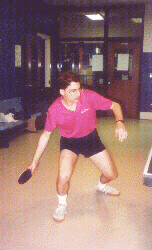
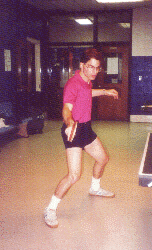
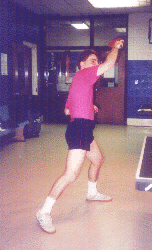
Photo 1 Photo 2 Photo 3
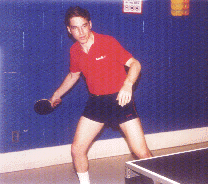
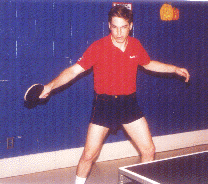
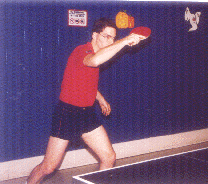
Photo 4 Photo 5 Photo 6